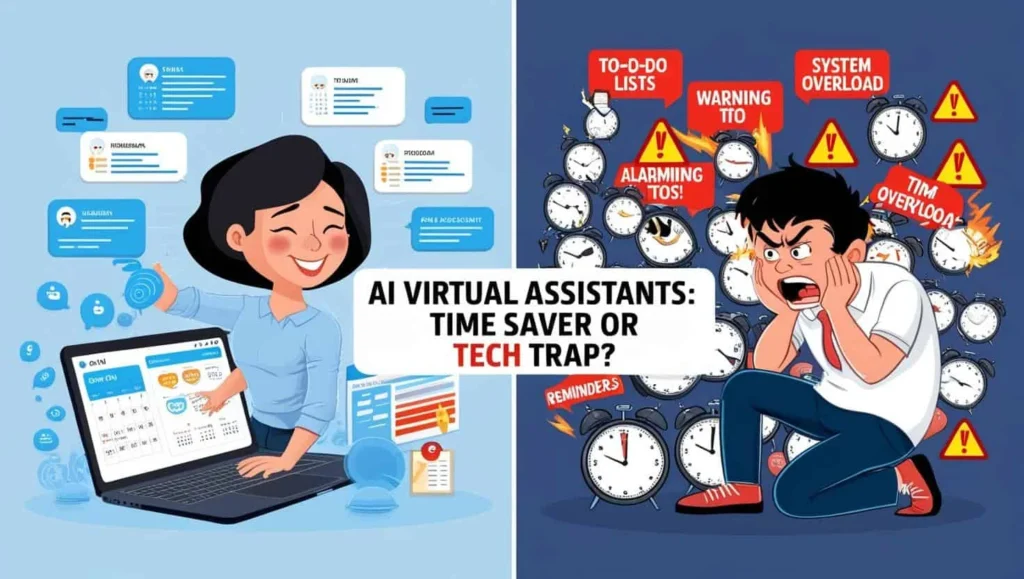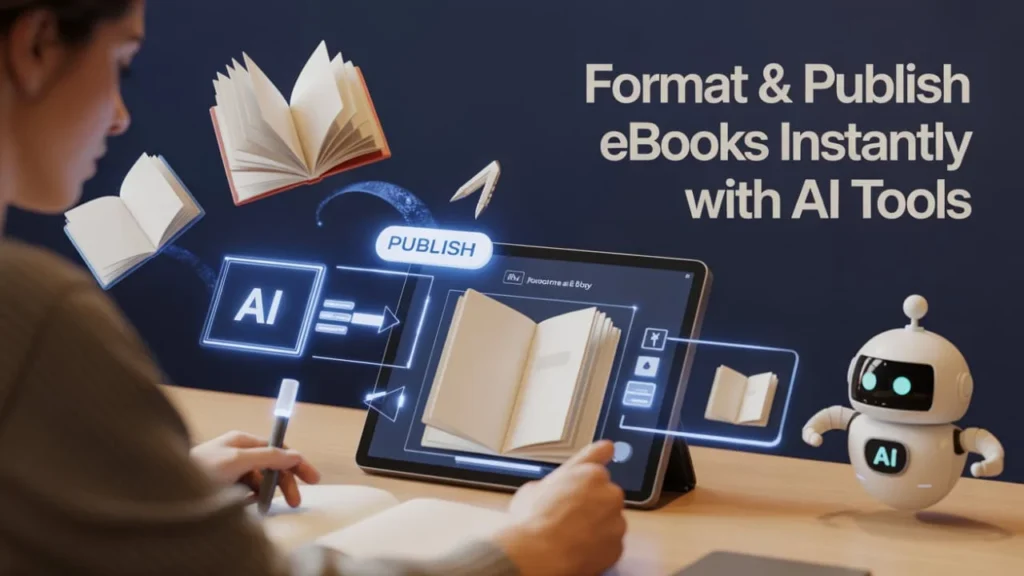AI Virtual Assistants are changing the game—but are they saving time or making us tech-dependent? Discover the truth in this insightful deep dive.

AI Virtual Assistants
Let me take you back to a Tuesday morning, not so far from today. Coffee in one hand, laptop in front of me, and deadlines looming ahead. I was busy with meetings, emails, and an everlasting dilemma of the day: what to post on LinkedIn that day. And then came a soft, slight chime from my AI Virtual Assistant. “Here is your daily schedule. Would you like to send a reminder to your call with Sarah at 2 PM?”
That wave of relief. Just for a second, I thought: Thank God for technology. Yet this tiny voice inside me said: Are we really in control anymore?
You are now in the age of AI Virtual Assistants. These modern-day digital aides promise to work wonders in making life smooth, enhance productivity, and replenish our most precious resource: time. But, are they the best hack for productivity, or simply that shiny object that makes us reliant on technology?
Let’s break it down, human to human.
What Exactly Are AI Virtual Assistants?
To begin with, let’s moisten a little bit of mystery. These AI Virtual Assistants are usually the software-based tools made to act like human beings in interaction and task performance. Think Siri, Alexa, Google Assistant, or more advanced platforms like ChatGPT and Replika. Some are voice-activated, others live within your phone or desktop. They make appointments, answer questions, set reminders, compose letters, and sometimes tell jokes.
And they’re getting smarter every day.
Natural Language Processing (NLP), Machine Learning (ML), and data analysis tie it all together. They listen to how you talk and learn what you do and when you do it, live with what they suss, remember, and eventually even become better.
Sounds magical, right? But wait.
The Perks: Why Everyone’s Talking About Them
1. Time-Saving Superpowers
Conjure up an idea that saves you sometime scrolling through your calendar just to know if you are free on that date. Compose that email over and over from scratch. AI Virtual Assistants do the heavy lifting on all these tasks.
With the right settings, they can:
- Schedule meetings
- Send follow-ups
- Generate reports
- Handle simple customer service queries
- Even write that birthday message you almost forgot
It gains you extra hours every week. An extra hour is life saving for solopreneurs and many startup founders.
2. Consistency You Can Count On
Ours are the moods of man. We forget. AI, however, does not know those moods. It does not know fatigue, or distraction. It wakes up and does the job the very same way, every single time.
For a business to create a brand or grow, consistency is paramount. AI guarantees customer responses, tone of content, and internal communication remain on-brand all the time, every day of the week.
3. Cost-Efficient and Scalable
Well, it does take money to hire a human assistant. A really good one? Even more.
I almost forgot: the subscription models from AI Virtual Assistants, or quite the opposite, are free. One does not need to worry about their benefits, office space, or training. With growing businesses, they so scale effortlessly. No interview process is needed.
It sounds like utopia, doesn’t it?
The Hidden Downsides No One Talks About
Here comes the plot twist.
1. Are You Losing the Human Touch?
Let’s get right down to it. When it comes down to it, there is no replacing human interaction. You know-two people just sit talking to each other, oblivious of the outside world.
AI can copy tonalities but won’t feel. It can respond but doesn’t empathize.
Your brand is created on relationships (let’s face it, most are). Too much automation will backfire. Because, deep down, customers know when they are being talked to by automation and, at times, don’t like it.
Let us be honest. There is something inalterable about human feelings. A response with sincerity. A handwritten card. An unscripted talk.
Humans, however, show no emotions in their reactions. AI mimics tonally. It reacts but not feels.
If your brand has relationships (and let’s face it, most do), then excessiveness in automation would probably backfire on you. Customers can easily tell when they are engaged by a bot. And sometimes, they just don’t like it.
2. The Illusion of Productivity
Scheduled 15 meetings. Tackled 47 emails. Drafted three blog posts. Productive day, or so it seems, right? Not really.
You feel busy these days, as if you have been doing more work. But the question is: have you been productive? Or just ticked a few checklists?
It’s something we can all relate to.
3. Data Privacy and Security
This is really something big.
Your AI assistant knows your wake-up hours, whom you call, the conversations, and your mood. That’s a huge chunk of data.
So what happens when a breach occurs?
Or one harsher scenario: the platform uses all this data to further train its models. This, unfortunately, will not be revealed by every company. And the fine print? Good luck reading it!
Real-Life Use Cases: The Good, the Bad & the Quirky
The Good:
Consider James, a freelance marketer. He has an AI assistant organize client calls, transcribe meetings, and write the first draft of his newsletters. Result? Increased clients twofold without draining himself.
The Bad:
Now you will come to know Priya, who is the one to automate customer service using an AI chatbot. But she never monitored it. Complaints were misunderstood, wrong refunds were given, and she was almost losing a big client.
Lesson: The need for monitoring with any automation.
The Quirky:
And then there is Leo, who trained his AI assistant to insert dad jokes into emails. His open rates skyrocketed, and now he is known as “the funny finance guy.”
If it works, it works.
So, Should You Use an AI Virtual Assistant?
The fact of the matter is that: It depends.
When weighed down with loads of admin tasks, AI can become a life-saver; when it comes to impressing customers or providing a personalized service, tread carefully.
Try asking yourself:
- What do I actually need help with?
- Is this task repetitive or creative?
- Will my customers notice the difference?
However, it would be much better if you can begin at a smaller scale. Automate your calendar-and then get a personal assistant to draft your to-do list. Let it write your first email-but you hit send. Retain control. And stay curious.
My Take: It’s Not Either-Or
Here is a deal. AI Virtual Assistants have not come to replace you; they have come to add more wings to you.
Like the Swiss Army knife, they are a tool. And they are a really, really smart tool.
But you’d still need to wield it wisely.
Technology is only as great as the human using it. So, do not seek convenience; seek impact. And never let technology do the talking for you when it should be talking with you.
Actionable Takeaway
If you’re considering AI Virtual Assistants, do this:
- Audit your tasks — List everything you do in a week.
- Pick the repetitive ones — These are ripe for automation.
- Test one assistant — Try something like Motion, Notion AI, or Otter.ai.
- Track your time saved — If you’re not saving at least 3 hours a week, adjust.
- Stay human — Always review and personalize the important stuff.
To become less human should never be the goal; rather it should enable all those things that do not require your soul to be handled by AI.
At the end of the day, the AI Virtual Assistant is only a trap if you forget who is in control.
So, big spoiler alert: it should always be you.
Create & Sell AI‑Generated Art: Top Generator Tools
Create and sell stunning AI-Generated Art with top tools. Explore platforms that turn creativity into…
Spark Creative Ideas: AI‑Powered Brainstorming Platforms
Unlock endless creativity with AI-powered brainstorming platforms. Discover smart platforms to spark ideas faster and…
Format and Publish eBooks Instantly with AI Tools
Discover how to format and publish eBooks instantly using AI tools. Learn step-by-step, see real…
Sell AI‑Generated Code Templates as a Freelance Service
by Arham Khan, blogger and AI enthusiast Learn how to profit by selling AI‑Generated Code…
AI print‑on‑demand side hustle with Shopify: A Beginner’s Guide
Start your AI print‑on‑demand side hustle on Shopify today—learn step-by-step, see real examples, and scale…
AI Storyboard Sketch Tool for Filmmakers: Create Storyboards in Seconds
Discover how an AI storyboard sketch tool for filmmakers lets you draft professional boards in…






